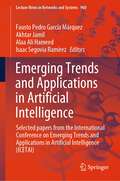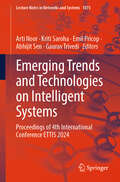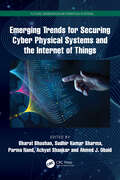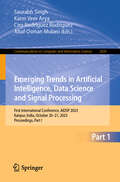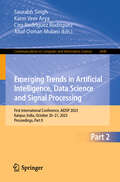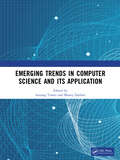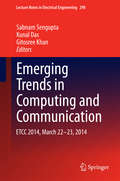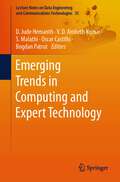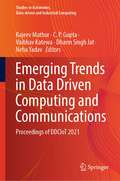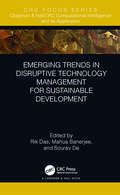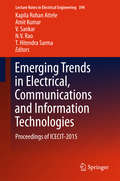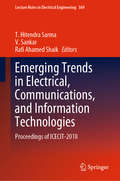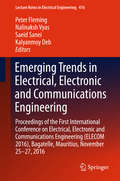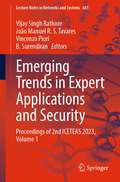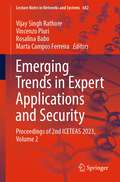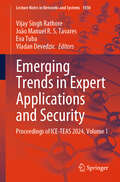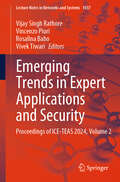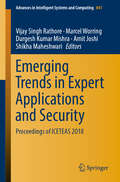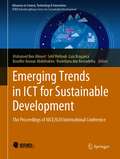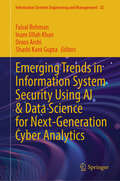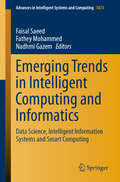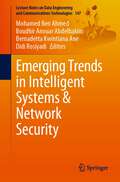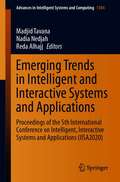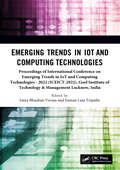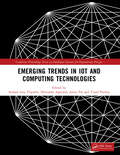- Table View
- List View
Emerging Trends and Applications in Artificial Intelligence: Selected papers from the International Conference on Emerging Trends and Applications in Artificial Intelligence (ICETAI) (Lecture Notes in Networks and Systems #960)
by Fausto Pedro García Márquez Akhtar Jamil Alaa Ali Hameed Isaac Segovia RamírezThe book covers the proceedings of the International Conference on Emerging Trends and Applications in Artificial Intelligence (ICETAI) held at Istanbul Medipol University, Turkey, on 24 – 25 August 2023. It presents a comprehensive compilation of papers covering the forefront of artificial intelligence, encapsulating state-of-the-art models, innovative methodologies applied to benchmark datasets, and incisive analyses addressing contemporary challenges. Encompassing four pivotal tracks—Artificial Intelligence and Machine Learning, Big Data and Cloud Computing, Internet of Things and Sensor Technology, and Applications of Artificial Intelligence—this volume serves as a vital resource for researchers, scholars, and professionals navigating the multifaceted landscape of AI advancements and their real-world applications across diverse domains.
Emerging Trends and Technologies on Intelligent Systems: Proceedings of 4th International Conference ETTIS 2024 (Lecture Notes in Networks and Systems #1073)
by Emil Pricop Arti Noor Abhijit Sen Gaurav Trivedi Kriti SarohaThis book presents best selected papers presented at the 4th International Conference on Emerging Trends and Technologies on Intelligent Systems (ETTIS 2024) held from 27 to 28 March 2024 in hybrid mode at CDAC, Noida, India. The book includes current research works in the areas of artificial intelligence, big data, cyber-physical systems, and security in industrial/real-world settings. The book illustrates on-going research results, projects, surveying works, and industrial experiences that describe significant advances in all of the related areas.
Emerging Trends for Securing Cyber Physical Systems and the Internet of Things (Future Generation Information Systems)
by Bharat Bhushan Sudhir Kumar Sharma Ahmed J. Obaid Achyut Shankar Parma NandIn the past decades, cyber-physical systems (CPSs) have been widely applied to fields such as smart grids, environment monitoring, aerospace, smart transportation, and industrial automation. Great strides have been made in CPSs to improve the computing mechanism, communication, and quality of service by applying optimization algorithms. Currently, these efforts are integrated with the applications of machine learning (ML) and artificial intelligence (AI). To maintain system reliability and stability, CPSs such as smart grids face numerous challenges, including large-scale Internet-of-Things (IoT) device adaptation, ever-increasing demands of electrical energy, and the rise of a wide range of security threats. These challenges bring forth the need to find sustainable and advanced solutions to guarantee reliable and secure operations in these systems.The goal of this book is to foster transformative, multidisciplinary, and novel approaches that ensure CPS security by taking into consideration the unique security challenges present in the environment. This book attracts contributions in all aspects pertaining to this multidisciplinary paradigm, which includes the development and implementation of Smart CPS, Supervisory Control and Data Acquisition (SCADA) systems, CPS for Industry 4.0, CPS architecture for IoT applications, and CPS forensics.This book: Discusses concepts including wireless sensor networks (WSNs), CPSs, and the IoT in a comprehensive manner. Covers routing protocols in sensor networks, attacks, and vulnerabilities in WSNs, the Internet of Cyber-Physical Things, and CPSs for industrial applications. Highlights technological advances, practical solutions, emerging trends, and prototypes related to privacy in CPSs and the IoT. Presents a pathway and architecture for proactive security schemes in CPSs to counter vulnerabilities, including phishing attacks, malware injection, internal stealing of data, and hacking. Discusses the most recent research and development on the enabling technologies for IoT-based CPSs. Owing to the scope and diversity of topics covered, the book will be of interest not only to researchers and theorists but also to professionals, material developers, technology specialists, and methodologists dealing with the multifarious aspects of data privacy and security enhancement in CPSs. The book will provide these professionals an overview of CPS security and privacy design, as well as enlighten them to promising solutions to research problems such as cyberattacks in CPS, risk identification and management in CPS, ML-based trust computational models for CPSs, nature-inspired algorithms for CPSs, and distributed consensus algorithms for event detection in CPSs. The secondary target audience of this book includes legal practitioners, hackers, cyber law policymakers, cyber forensic analysts, and global security consortiums who may use it to further their research exposure to pertinent topics in cybersecurity.
Emerging Trends in Artificial Intelligence, Data Science and Signal Processing: First International Conference, AIDSP 2023, Kanpur, India, October 20–21, 2023, Proceedings, Part I (Communications in Computer and Information Science #2439)
by Karm Veer Arya Saurabh Singh Ciro Rodriguez Rodriguez Altaf Osman MulaniThe two-volume set, CCIS 2439 and CCIS 2440, constitutes the proceedings of the First International Conference on Emerging Trends in Artificial Intelligence, Data Science and Signal Processing, AIDSP 2023, held in Kanpur, India, in October 2023. The 25 full papers and 11 Short papers in this book were carefully reviewed and selected from 260 submissions. These papers focus on the topics such as Artificial Intelligence, Machine Learning and Signal Processing.
Emerging Trends in Artificial Intelligence, Data Science and Signal Processing: First International Conference, AIDSP 2023, Kanpur, India, October 20–21, 2023, Proceedings, Part II (Communications in Computer and Information Science #2440)
by Karm Veer Arya Saurabh Singh Ciro Rodriguez Rodriguez Altaf Osman MulaniThe two-volume set, CCIS 2439 and CCIS 2440, constitutes the proceedings of the First International Conference on Emerging Trends in Artificial Intelligence, Data Science and Signal Processing, AIDSP 2023, held in Kanpur, India, in October 2023. The 25 full papers and 11 Short papers in this book were carefully reviewed and selected from 260 submissions. These papers focus on the topics such as Artificial Intelligence, Machine Learning and Signal Processing.
Emerging Trends in Computer Science and Its Application
by Anurag Tiwari Manuj DarbariThe conference brought together a diverse group of scholars, researchers, and industry professionals to engage in meaningful discussions and share insights on cutting-edge trends in artificial intelligence, machine learning, data science, and their multifaceted applications. This collaboration and knowledge exchange fostered an environment of innovation, making the conference a successful and impactful event for all participants. It aimed to highlight these significant advancements and serve as a valuable resource for researchers, academicians, and practitioners who wish to stay informed about the recent innovations and methodologies shaping the landscape of computational intelligence. By showcasing a wide range of research topics and practical implementations, it not only addressed the current challenges but also inspired new ideas and approaches for future research.
Emerging Trends in Computing and Communication
by Sabnam Sengupta Kunal Das Gitosree KhanThe book presents papers delivered by researchers, industrial experts and academicians at the Conference on Emerging Trends in Computing and Communication (ETCC 2014). As such, the book is a collection of recent and innovative works in the field Network Security and Cryptography, Cloud Computing and Big Data Analytics, Data Mining and Data Warehouse, Communication and Nanotechnology and VLSI and Image Processing.
Emerging Trends in Computing and Expert Technology (Lecture Notes on Data Engineering and Communications Technologies #35)
by Oscar Castillo D. Jude Hemanth V. D. Ambeth Kumar S. Malathi Bogdan PatrutThis book presents high-quality research papers that demonstrate how emerging technologies in the field of intelligent systems can be used to effectively meet global needs. The respective papers highlight a wealth of innovations and experimental results, while also addressing proven IT governance, standards and practices, and new designs and tools that facilitate rapid information flows to the user. The book is divided into five major sections, namely: “Advances in High Performance Computing”, “Advances in Machine and Deep Learning”, “Advances in Networking and Communication”, “Advances in Circuits and Systems in Computing” and “Advances in Control and Soft Computing”.
Emerging Trends in Data Driven Computing and Communications: Proceedings of DDCIoT 2021 (Studies in Autonomic, Data-driven and Industrial Computing)
by Neha Yadav Dharm Singh Jat Rajeev Mathur C. P. Gupta Vaibhav KatewaThis book includes best selected, high-quality research papers presented at International Conference on Data Driven Computing and IoT (DDCIoT 2021) organized jointly by Geetanjali Institute of Technical Studies (GITS), Udaipur, and Rajasthan Technical University, Kota, India, during March 20–21, 2021. This book presents influential ideas and systems in the field of data driven computing, information technology, and intelligent systems.
Emerging Trends in Disruptive Technology Management for Sustainable Development (Chapman & Hall/CRC Computational Intelligence and Its Applications)
by Sourav De Rik Das Mahua BanerjeeInterdisciplinary approaches using Machine Learning and Deep Learning techniques are smartly addressing real life challenges and have emerged as an inseparable element of disruption in current times. Applications of Disruptive Technology in Management practices are an ever interesting domain for researchers and professionals. This volume entitled Emerging Trends in Disruptive Technology Management for Sustainable Development has attempted to collate five different interesting research approaches that have innovatively reflected diverse potential of disruptive trends in the era of 4th. Industrial Revolution. The uniqueness of the volume is going to cater the entrepreneurs and professionals in the domain of artificial intelligence, machine learning, deep learning etc. with its unique propositions in each of the chapters. The volume is surely going to be a significant source of knowledge and inspiration to those aspiring minds endeavouring to shape their futures in the area of applied research in machine learning and computer vision. The expertise and experiences of the contributing authors to this volume is encompassing different fields of proficiencies. This has set an excellent prelude to discover the correlation among multidisciplinary approaches of innovation. Covering a broad range of topics initiating from IoT based sustainable development to crowd sourcing concepts with a blend of applied machine learning approaches has made this volume a must read to inquisitive wits. Features Assorted approaches to interdisciplinary research using disruptive trends Focus on application of disruptive technology in technology management Focus on role of disruptive technology on sustainable development Promoting green IT with disruptive technology The book is meant to benefit several categories of students and researchers. At the students' level, this book can serve as a treatise/reference book for the special papers at the masters level aimed at inspiring possibly future researchers. Newly inducted PhD aspirants would also find the contents of this book useful as far as their compulsory course-works are concerned. At the researchers' level, those interested in interdisciplinary research would also be benefited from the book. After all, the enriched interdisciplinary contents of the book would always be a subject of interest to the faculties, existing research communities and new research aspirants from diverse disciplines of the concerned departments of premier institutes across the globe. This is expected to bring different research backgrounds (due to its cross platform characteristics) close to one another to form effective research groups all over the world. Above all, availability of the book should be ensured to as much universities and research institutes as possible through whatever graceful means it may be. Hope this volume will cater as a ready reference to your quest for diving deep into the ocean of technology management for 4th. Industrial Revolution.
Emerging Trends in Electrical, Communications and Information Technologies
by Amit Kumar Kapila Rohan Attele V. Sankar N. V. Rao T. Hitendra SarmaThis book includes the original, peer-reviewed research from the 2nd International Conference on Emerging Trends in Electrical, Communication and Information Technologies (ICECIT 2015), held in December, 2015 at Srinivasa Ramanujan Institute of Technology, Ananthapuramu, Andhra Pradesh, India. It covers the latest research trends or developments in areas of Electrical Engineering, Electronic and Communication Engineering, and Computer Science and Information.
Emerging Trends in Electrical, Communications, and Information Technologies: Proceedings of ICECIT-2018 (Lecture Notes in Electrical Engineering #569)
by V. Sankar T. Hitendra Sarma Rafi Ahamed ShaikThis book includes original, peer-reviewed research from the 3rd International Conference on Emerging Trends in Electrical, Communication and Information Technologies (ICECIT 2018), held at Srinivasa Ramanujan Institute of Technology, Ananthapuramu, Andhra Pradesh, India in December 2018. It covers the latest research trends and developments in the areas of Electrical Engineering, Electronic and Communication Engineering, and Computer Science and Information.
Emerging Trends in Electrical, Electronic and Communications Engineering
by Peter Fleming Kalyanmoy Deb Saeid Sanei Nalinaksh VyasThe book reports on advanced theories and methods in two related engineering fields: electrical and electronic engineering, and communications engineering and computing. It highlights areas of global and growing importance, such as renewable energy, power systems, mobile communications, security and the Internet of Things (IoT). The contributions cover a number of current research issues, including smart grids, photovoltaic systems, wireless power transfer, signal processing, 4G and 5G technologies, IoT applications, mobile cloud computing and many more. Based on the proceedings of the first International Conference on Emerging Trends in Electrical, Electronic and Communications Engineering (ELECOM 2016), held in Voila Bagatelle, Mauritius from November 25 to 27, 2016, the book provides graduate students, researchers and professionals with a snapshot of the state-of-the-art and a source of new ideas for future research and collaborations.
Emerging Trends in Expert Applications and Security: Proceedings of 2nd ICETEAS 2023, Volume 1 (Lecture Notes in Networks and Systems #681)
by Vincenzo Piuri João Manuel R. S. Tavares Vijay Singh Rathore B. SurendiranThe book covers current developments in the field of computer system security using cryptographic algorithms and other security schemes for system as well as cloud. The proceedings compiles the selected research papers presented at ICE-TEAS 2023 Conference held at Jaipur Engineering College and Research Centre, Jaipur, India, during February 17–19, 2023. The book focuses on expert applications and artificial intelligence; information and application security; advanced computing; multimedia applications in forensics, security, and intelligence; and advances in web technologies: implementation and security issues.
Emerging Trends in Expert Applications and Security: Proceedings of 2nd ICETEAS 2023, Volume 2 (Lecture Notes in Networks and Systems #682)
by Vincenzo Piuri Rosalina Babo Vijay Singh Rathore Marta Campos FerreiraThe book covers current developments in the field of computer system security using cryptographic algorithms and other security schemes for system as well as cloud. The proceedings compile the selected research papers presented at ICE-TEAS 2023 Conference held at Jaipur Engineering College and Research Centre, Jaipur, India, during February 17–19, 2023. The book focuses on expert applications and artificial intelligence; information and application security; advanced computing; multimedia applications in forensics, security, and intelligence; and advances in web technologies: implementation and security issues.
Emerging Trends in Expert Applications and Security: Proceedings of ICE-TEAS 2024, Volume 1 (Lecture Notes in Networks and Systems #1030)
by João Manuel R. S. Tavares Vijay Singh Rathore Vladan Devedzic Eva TubaThe book covers current developments in the field of computer system security using cryptographic algorithms and other security schemes for system as well as cloud. The proceedings compiles the selected research papers presented at ICE-TEAS 2024 Conference held at Jaipur Engineering College and Research Centre, Jaipur, India, during March 15–17, 2024. The book focuses on expert applications and artificial intelligence; information and application security; advanced computing; multimedia applications in forensics, security, and intelligence; and advances in web technologies: implementation and security issues.
Emerging Trends in Expert Applications and Security: Proceedings of ICE-TEAS 2024, Volume 2 (Lecture Notes in Networks and Systems #1037)
by Vincenzo Piuri Vivek Tiwari Rosalina Babo Vijay Singh RathoreThe book covers current developments in the field of computer system security using cryptographic algorithms and other security schemes for system as well as cloud. The proceedings compiles the selected research papers presented at ICE-TEAS 2024 Conference held at Jaipur Engineering College and Research Centre, Jaipur, India, during March 15–17, 2024. The book focuses on expert applications and artificial intelligence; information and application security; advanced computing; multimedia applications in forensics, security, and intelligence; and advances in web technologies: implementation and security issues.
Emerging Trends in Expert Applications and Security: Proceedings of ICETEAS 2018 (Advances in Intelligent Systems and Computing #841)
by Marcel Worring Amit Joshi Durgesh Kumar Mishra Vijay Singh Rathore Shikha MaheshwariThe book covers current developments in the field of expert applications and security, which employ advances of next-generation communication and computational technology to shape real-world applications. It gathers selected research papers presented at the ICETEAS 2018 conference, which was held at Jaipur Engineering College and Research Centre, Jaipur, India, on February 17–18, 2018. Key topics covered include expert applications and artificial intelligence; information and application security; advanced computing; multimedia applications in forensics, security and intelligence; and advances in web technologies: implementation and security issues.
Emerging Trends in ICT for Sustainable Development: The Proceedings of NICE2020 International Conference (Advances in Science, Technology & Innovation)
by Mohamed Ben Ahmed Sehl Mellouli Luis Braganca Boudhir Anouar Abdelhakim Kwintiana Ane BernadettaThis book features original research and recent advances in ICT fields related to sustainable development. Based the International Conference on Networks, Intelligent systems, Computing & Environmental Informatics for Sustainable Development, held in Marrakech in April 2020, it features peer-reviewed chapters authored by prominent researchers from around the globe. As such it is an invaluable resource for courses in computer science, electrical engineering and urban sciences for sustainable development. This book covered topics including• Green Networks • Artificial Intelligence for Sustainability• Environment Informatics• Computing Technologies
Emerging Trends in Information System Security Using AI & Data Science for Next-Generation Cyber Analytics (Information Systems Engineering and Management #32)
by Inam Ullah Khan Shashi Kant Gupta Oroos Arshi Faisal RehmanThis book is a comprehensive exploration into the intersection of cutting-edge technologies and the critical domain of cybersecurity; this book delves deep into the evolving landscape of cyber threats and the imperative for innovative solutions. From establishing the fundamental principles of cyber security to scrutinizing the latest advancements in AI and machine learning, each chapter offers invaluable insights into bolstering defenses against contemporary threats. Readers are guided through a journey that traverses the realms of cyber analytics, threat analysis, and the safeguarding of information systems in an increasingly interconnected world. With chapters dedicated to exploring the role of AI in securing IoT devices, employing supervised and unsupervised learning techniques for threat classification, and harnessing the power of recurrent neural networks for time series analysis, this book presents a holistic view of the evolving cybersecurity landscape. Moreover, it highlights the importance of next-generation defense mechanisms, such as generative adversarial networks (GANs) and federated learning techniques, in combating sophisticated cyber threats while preserving privacy. This book is a comprehensive guide to integrating AI and data science into modern cybersecurity strategies. It covers topics like anomaly detection, behaviour analysis, and threat intelligence, and advocates for proactive risk mitigation using AI and data science. The book provides practical applications, ethical considerations, and customizable frameworks for implementing next-gen cyber defense strategies. It bridges theory with practice, offering real-world case studies, innovative methodologies, and continuous learning resources to equip readers with the knowledge and tools to mitigate cyber threats.
Emerging Trends in Intelligent Computing and Informatics: Data Science, Intelligent Information Systems and Smart Computing (Advances in Intelligent Systems and Computing #1073)
by Faisal Saeed Nadhmi Gazem Fathey MohammedThis book presents the proceedings of the 4th International Conference of Reliable Information and Communication Technology 2019 (IRICT 2019), which was held in Pulai Springs Resort, Johor, Malaysia, on September 22–23, 2019. Featuring 109 papers, the book covers hot topics such as artificial intelligence and soft computing, data science and big data analytics, internet of things (IoT), intelligent communication systems, advances in information security, advances in information systems and software engineering.
Emerging Trends in Intelligent Systems & Network Security (Lecture Notes on Data Engineering and Communications Technologies #147)
by Mohamed Ben Ahmed Bernadetta Kwintiana Ane Boudhir Anouar Abdelhakim Didi RosiyadiThis book covers selected research works presented at the fifth International Conference on Networking, Information Systems and Security (NISS 2022), organized by the Research Center for Data and Information Sciences at the National Research and Innovation Agency (BRIN), Republic of Indonesia, and Moroccan Mediterranean Association of Sciences and Sustainable Development, Morocco, during March 30–31, 2022, hosted in online mode in Bandung, Indonesia. Building on the successful history of the conference series in the recent four years, this book aims to present the paramount role of connecting researchers around the world to disseminate and share new ideas in intelligent information systems, cyber-security, and networking technologies. The 49 chapters presented in this book were carefully reviewed and selected from 115 submissions. They focus on delivering intelligent solutions through leveraging advanced information systems, networking, and security for competitive advantage and cost savings in modern industrial sectors as well as public, business, and education sectors. Authors are eminent academicians, scientists, researchers, and scholars in their respective fields from across the world.
Emerging Trends in Intelligent and Interactive Systems and Applications: Proceedings of the 5th International Conference on Intelligent, Interactive Systems and Applications (IISA2020) (Advances in Intelligent Systems and Computing #1304)
by Madjid Tavana Reda Alhajj Nadia NedjahThis book reports on the proceeding of the 5th International Conference on Intelligent, Interactive Systems and Applications (IISA 2020), held in Shanghai, China, on September 25–27, 2020. The IISA proceedings, with the latest scientific findings, and methods for solving intriguing problems, are a reference for state-of-the-art works on intelligent and interactive systems. This book covers nine interesting and current topics on different systems’ orientations, including Analytical Systems, Database Management Systems, Electronics Systems, Energy Systems, Intelligent Systems, Network Systems, Optimization Systems, and Pattern Recognition Systems and Applications. The chapters included in this book cover significant recent developments in the field, both in terms of theoretical foundations and their practical application. An important characteristic of the works included here is the novelty of the solution approaches to the most interesting applications of intelligent and interactive systems.
Emerging Trends in IoT and Computing Technologies: Proceedings of the International Conference on Emerging Trends in IoT and Computing Technologies (ICEICT-2022), April 22-23, 2022, Lucknow, India
by Suman Lata Tripathi Satya Bhushan VermaThis book includes the proceedings of the International Conference on Emerging Trends in IoT and Computing Technologies (ICEICT-2022) held at Goel Institute of Technology & Management, Lucknow, India.
Emerging Trends in IoT and Computing Technologies: Proceedings of the International Conference on Emerging Trends in IoT and Computing Technologies-2023 (Conference Proceedings Series on Intelligent Systems for Engineering Designs)
by Suman Lata Tripathi Devendra Agarwal Anita Pal Yusuf PerwejSecond International Conference on Emerging Trends in IOT and Computing Technologies (ICEICT – 2023) is organised with a vision to address the various issues to promote the creation of intelligent solution for the future. It is expected that researchers will bring new prospects for collaboration across disciplines and gain ideas facilitating novel concepts. Second International Conference of Emerging Trends in IoT and Computer Technologies (ICEICT-2023) is an inventive event organised in Goel Institute of Technology and Management, Lucknow, India, with motive to make available an open International forum for the researches, academicians, technocrats, scientist, engineers, industrialist and students around the globe to exchange their innovations and share the research outcomes which may lead the young researchers, academicians and industrialist to contribute to the global society. The conference ICEICT- 2023 is being organised at Goel Institute of Technology and Management, Lucknow, Uttar Pradesh, during 12-13 January 2024. It will feature world-class keynote speakers, special sessions, along with the regular/oral paper presentations. The conference welcomes paper submissions from researcher, practitioners, academicians and students will cover numerous tracks in the field of Computer Science and Engineering and associated research areas.
